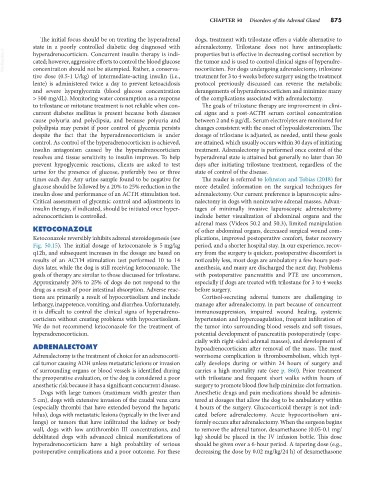Page 903 - Small Animal Internal Medicine, 6th Edition
P. 903
CHAPTER 50 Disorders of the Adrenal Gland 875
The initial focus should be on treating the hyperadrenal dogs, treatment with trilostane offers a viable alternative to
state in a poorly controlled diabetic dog diagnosed with adrenalectomy. Trilostane does not have antineoplastic
VetBooks.ir hyperadrenocorticism. Concurrent insulin therapy is indi- properties but is effective in decreasing cortisol secretion by
the tumor and is used to control clinical signs of hyperadre-
cated; however, aggressive efforts to control the blood glucose
concentration should not be attempted. Rather, a conserva-
treatment for 3 to 4 weeks before surgery using the treatment
tive dose (0.5-1 U/kg) of intermediate-acting insulin (i.e., nocorticism. For dogs undergoing adrenalectomy, trilostane
lente) is administered twice a day to prevent ketoacidosis protocol previously discussed can reverse the metabolic
and severe hyperglycemia (blood glucose concentration derangements of hyperadrenocorticism and minimize many
> 500 mg/dL). Monitoring water consumption as a response of the complications associated with adrenalectomy.
to trilostane or mitotane treatment is not reliable when con- The goals of trilostane therapy are improvement in clini-
current diabetes mellitus is present because both diseases cal signs and a post-ACTH serum cortisol concentration
cause polyuria and polydipsia, and because polyuria and between 2 and 6 µg/dL. Serum electrolytes are monitored for
polydipsia may persist if poor control of glycemia persists changes consistent with the onset of hypoaldosteronism. The
despite the fact that the hyperadrenocorticism is under dosage of trilostane is adjusted, as needed, until these goals
control. As control of the hyperadrenocorticism is achieved, are attained, which usually occurs within 30 days of initiating
insulin antagonism caused by the hyperadrenocorticism treatment. Adrenalectomy is performed once control of the
resolves and tissue sensitivity to insulin improves. To help hyperadrenal state is attained but generally no later than 30
prevent hypoglycemic reactions, clients are asked to test days after initiating trilostane treatment, regardless of the
urine for the presence of glucose, preferably two or three state of control of the disease.
times each day. Any urine sample found to be negative for The reader is referred to Johnston and Tobias (2018) for
glucose should be followed by a 20% to 25% reduction in the more detailed information on the surgical techniques for
insulin dose and performance of an ACTH stimulation test. adrenalectomy. Our current preference is laparoscopic adre-
Critical assessment of glycemic control and adjustments in nalectomy in dogs with noninvasive adrenal masses. Advan-
insulin therapy, if indicated, should be initiated once hyper- tages of minimally invasive laparoscopic adrenalectomy
adrenocorticism is controlled. include better visualization of abdominal organs and the
adrenal mass (Videos 50.2 and 50.3), limited manipulation
KETOCONAZOLE of other abdominal organs, decreased surgical wound com-
Ketoconazole reversibly inhibits adrenal steroidogenesis (see plications, improved postoperative comfort, faster recovery
Fig. 50.15). The initial dosage of ketoconazole is 5 mg/kg period, and a shorter hospital stay. In our experience, recov-
q12h, and subsequent increases in the dosage are based on ery from the surgery is quicker, postoperative discomfort is
results of an ACTH stimulation test performed 10 to 14 noticeably less, most dogs are ambulatory a few hours post-
days later, while the dog is still receiving ketoconazole. The anesthesia, and many are discharged the next day. Problems
goals of therapy are similar to those discussed for trilostane. with postoperative pancreatitis and PTE are uncommon,
Approximately 20% to 25% of dogs do not respond to the especially if dogs are treated with trilostane for 3 to 4 weeks
drug as a result of poor intestinal absorption. Adverse reac- before surgery.
tions are primarily a result of hypocortisolism and include Cortisol-secreting adrenal tumors are challenging to
lethargy, inappetence, vomiting, and diarrhea. Unfortunately, manage after adrenalectomy, in part because of concurrent
it is difficult to control the clinical signs of hyperadreno- immunosuppression, impaired wound healing, systemic
corticism without creating problems with hypocortisolism. hypertension and hypercoagulation, frequent infiltration of
We do not recommend ketoconazole for the treatment of the tumor into surrounding blood vessels and soft tissues,
hyperadrenocorticism. potential development of pancreatitis postoperatively (espe-
cially with right-sided adrenal masses), and development of
ADRENALECTOMY hypoadrenocorticism after removal of the mass. The most
Adrenalectomy is the treatment of choice for an adrenocorti- worrisome complication is thromboembolism, which typi-
cal tumor causing ADH unless metastatic lesions or invasion cally develops during or within 24 hours of surgery and
of surrounding organs or blood vessels is identified during carries a high mortality rate (see p. 860). Prior treatment
the preoperative evaluation, or the dog is considered a poor with trilostane and frequent short walks within hours of
anesthetic risk because it has a significant concurrent disease. surgery to promote blood flow help minimize clot formation.
Dogs with large tumors (maximum width greater than Anesthetic drugs and pain medications should be adminis-
5 cm), dogs with extensive invasion of the caudal vena cava tered at dosages that allow the dog to be ambulatory within
(especially thrombi that have extended beyond the hepatic 4 hours of the surgery. Glucocorticoid therapy is not indi-
hilus), dogs with metastatic lesions (typically in the liver and cated before adrenalectomy. Acute hypocortisolism uni-
lungs) or tumors that have infiltrated the kidney or body formly occurs after adrenalectomy. When the surgeon begins
wall, dogs with low antithrombin III concentrations, and to remove the adrenal tumor, dexamethasone (0.05-0.1 mg/
debilitated dogs with advanced clinical manifestations of kg) should be placed in the IV infusion bottle. This dose
hyperadrenocorticism have a high probability of serious should be given over a 6-hour period. A tapering dose (e.g.,
postoperative complications and a poor outcome. For these decreasing the dose by 0.02 mg/kg/24 h) of dexamethasone

